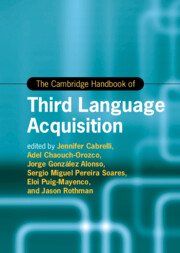Book contents
- The Cambridge Handbook of Third Language Acquisition
- Cambridge Handbooks in Language and Linguistics
- The Cambridge Handbook of Third Language Acquisition
- Copyright page
- Contents
- Figures
- Tables
- Contributors
- Introduction Multilingualism
- Part I Theoretical Approaches to L3/Ln
- Part II L3/Ln across Linguistic Domains
- Part III Becoming and Staying Multilingual at Different Ages
- Part IV L3/Ln in Action
- Part V L3/Ln and Cognition
- 20 Multilingualism and Cognitive Control in the Brain
- 21 Multilingualism and Cognitive Reserve
- 22 The Effects of Multilingualism on Brain Structure, Language Control and Language Processing
- 23 Mechanisms of Cognitive Aging in Multilingualism
- 24 Multilingualism and Language Impairment
- Part VI Research Methods in L3/Ln
- Index
- References
24 - Multilingualism and Language Impairment
from Part V - L3/Ln and Cognition
Published online by Cambridge University Press: 13 July 2023
- The Cambridge Handbook of Third Language Acquisition
- Cambridge Handbooks in Language and Linguistics
- The Cambridge Handbook of Third Language Acquisition
- Copyright page
- Contents
- Figures
- Tables
- Contributors
- Introduction Multilingualism
- Part I Theoretical Approaches to L3/Ln
- Part II L3/Ln across Linguistic Domains
- Part III Becoming and Staying Multilingual at Different Ages
- Part IV L3/Ln in Action
- Part V L3/Ln and Cognition
- 20 Multilingualism and Cognitive Control in the Brain
- 21 Multilingualism and Cognitive Reserve
- 22 The Effects of Multilingualism on Brain Structure, Language Control and Language Processing
- 23 Mechanisms of Cognitive Aging in Multilingualism
- 24 Multilingualism and Language Impairment
- Part VI Research Methods in L3/Ln
- Index
- References
Summary
In this chapter, we review studies of multilingual people with language impairments, specifically autism, dyslexia, and developmental language disorder in children, and aphasia and traumatic brain injury in adults. We address three topics that have emerged: disadvantages and advantages of being multilingual, the manifestation of impairments across different languages, and cross-language effects following intervention. Whereas the field of language impairment and bilingualism has seen a growth in the number of publications, only a few studies have focused specifically on multilingual people, and even fewer have compared multilingual to bilingual individuals. Methodological differences among the studies and the limited amount of data for each communication disorder impede our ability to draw consistent conclusions. Despite these limitations, we discuss common themes and point to future directions. Furthermore, we propose that the study of more than two languages can add to our understanding of key aspects of language impairment, representation, and processing.
- Type
- Chapter
- Information
- The Cambridge Handbook of Third Language Acquisition , pp. 633 - 658Publisher: Cambridge University PressPrint publication year: 2023

